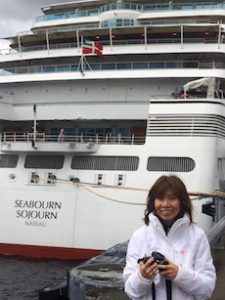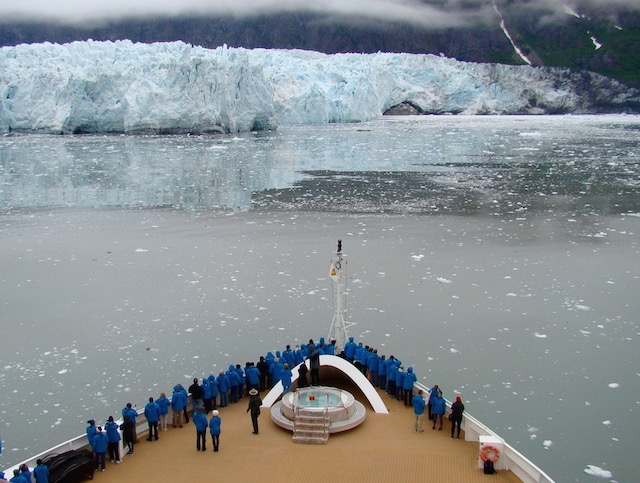Luxury cruise line Seabourn returns to Alaska for the first time in 15 years. What does an Alaska cruise offer and what is it like to do it with Seabourn? Raini Hamdi finds out
Why
I’ve always been intrigued by Seabourn, one of the revered names in luxury cruising. It popped up again on my radar in January this year when its newest ship, Seabourn Encore, had a naming ceremony in Singapore before going on its inaugural voyage, Gems of the Java Sea. Another new ship, Seabourn Ovation, will set sail next year. I guess we’ll be hearing a lot more about Seabourn, with well-heeled Asian clients always wanting new products and exotic journeys.
As it happened, Seabourn was returning to Alaska for the first time in 15 years, sailing there June to September. So I picked an ‘Ultimate Alaska’ on Seabourn Sojourn which started on June 1 in Vancouver and ended in Seward (Anchorage) in Alaska on June 12.
What
This is an ‘Inside Passage’ cruise, offering sailing inside fjords – narrow, deep inlets that protect the ship from open seas. It also means only smaller ships such as Seabourn Sojourn – 198m long, 32,346 gross tonnage, 225 staterooms – can navigate through the channels.

The magnificence of an Inside Passage to Alaska hit me the morning I woke up to a spellbinding scenery of high cliffs, snow-capped mountains and forested islands as the ship wound its way around narrows, bays, straits and arms.
There were six ports-of-call between Vancouver and Seward. The noteworthy ones for me were Ketchikan, Sitka and Juneau.
Ketchikan, dubbed Alaska’s first city, is a showpiece of Tlingit culture, a native group known as warriors and artisans. It has the world’s largest collection of standing totem poles and I learnt a lot about the culture from my visit to the Totem Heritage Center.
I also enjoyed strolling through its former red-light district, Creek Street, where brothels now peddle souvenirs. But their bawdy past lives on through informative signage. One said: “Dolly’s House – where both men & salmon came upstream to spawn”.
The second port-of-call which made an impression on me, Sitka, is the former outpost of Imperial Russia, which sold Alaska to the US for a song – about US$7 million in 1867, or less than two cents an acre.
The Russian influence was palpable: The Russian Orthodox church is right in the heart of downtown. The Russian cemetery located in a nearby forest, with headstones crafted from the ballasts of Russian ships, is a poignant reminder of Sitka’s Russian past.
Apart from the history, I enjoyed a visit to the Alaska Raptor Center where I was able to get a close view of bald eagles and owls. These birds are injured and are being rehabilitated to fly again. A few never recover flight and remain in the outdoors at the centre for visitors to see them in the natural habitat.
The third, Juneau, is Alaska’s capital city, popular for its shopping streets lined with historic buildings such as the Alaskan Hotel & Bar which first opened in 1913, and for exciting shore excursions. I went on a gruelling seven-hour hike to Mendenhall Glacier – after all the eating and drinking on the ship, I needed it – but what got my heart racing on this excursion was a walk through a glacier tunnel. It was less than a minute as the opening was short, but it was as scary as it was exciting.
 Glaciers are a huge part of the attraction in an Alaskan cruise. In another excursion, I hopped onto a catamaran which snaked its way through the Endicott Arm Fjord to get as close as possible to a tidewater glacier and, as luck would have it, we were treated to three calvings. Two were spectacular, a cathedral of ice splitting off from the glacier and sinking straight into the sea with a thundering sound, creating a few waves in its wake.
Glaciers are a huge part of the attraction in an Alaskan cruise. In another excursion, I hopped onto a catamaran which snaked its way through the Endicott Arm Fjord to get as close as possible to a tidewater glacier and, as luck would have it, we were treated to three calvings. Two were spectacular, a cathedral of ice splitting off from the glacier and sinking straight into the sea with a thundering sound, creating a few waves in its wake.
The ship’s itinerary itself culminated in a visit to Glacier Bay National Park, a UNESCO Heritage Site. Only two vessels a day are allowed in the area, which boasts seven tidewater glaciers. To view the magnificence of the Margerie Glacier, which is about 1.6km wide and 76m high, in the open deck of this fine ship, in the company of other fellow guests in Seabourn jackets as blue as the ice before us, certainly was a highlight of the trip.
How
The ship was virtually full with 420 passengers, 266 of them from the US and the rest comprising 17 nationalities. With a crew of 42 nationalities, the onboard ambience felt fairly international, and attempts were made to cater to a diverse audience.
If I had to pick the three biggest strengths of the ship, it would have to be the F&B, room product and service.
Food was seriously good and I believe the ship’s collaboration with three-Michelin-star American chef Thomas Keller, the genius behind The French Laundry restaurant in Napa Valley, California, accounted for its delectable menus. For 11 nights, we were never bored by the F&B; in fact it became an enjoyable ritual for us each morning to go through the daily card sent to our room and see what’s on the menu at The Restaurant, the most elegant dining room serving fine Western; Restaurant 2, a small, by-reservations-only venue serving fine French cuisine; The Colonnade, which served a theme buffet dinner each night (on this journey it included Indian, Chinese, Vietnamese and Japanese); and The Patio Grill, casual alfresco dining.
I particularly like the minimal food waste. I get put off by large portions but they were perfect on this ship. If you wanted more, you could always have more.
Our service encounters, you can imagine, were mostly with the hardworking staff in the restaurants and in a total of six lounges and bars. Whether they were restaurant captains such as Diana at The Restaurant or Will at The Colonnade, experienced service staff such as Alberto and Vladdimiey at The Restaurant, and Daniel and Eiki at The Colonnade, or younger ones such as Maria and Francoise at the Observation Bar, whether they were from Columbia, the UK, Malaysia, Ukraine, Japan, Canada or South Africa, what they had in common were a warm and friendly disposition and an eagerness to be of service. No request was received as if it were a nuisance; none was ever forgotten.
As for the accommodation, my room was better than many hotel rooms I’ve stayed in. It had a large balcony, a living room with dining table and sofa, a bedroom, a walk-in closet and a bathroom with bathtub, separate shower and two washbasins. The water pressure was excellent, so was the lighting in the bathroom. There were more drawers and shelves for our clothes and belongings than we could use.
The ship also got the pricing for extras right. While the cruise was virtually all-inclusive, I found prices for, say, the laundry or spa services to be fair. We could do unlimited laundry for US$50, for example. A professional shampoo, haircut and style was US$69.
However, a serious wrong was the slow Internet everywhere, particularly in-room. I understand however that the ship, in operation for six years now, will be making a few improvements.
On the other hand, I benefited greatly from a slow Internet actually. After an initial annoyance, I found myself working less and reading more – the collection of books and magazines available onboard was simply wonderful.
The ship also brought in rangers and expedition members under a programme called Ventures by Seabourn to give pointers and lectures on wildlife, geology and nature. Destination talks were conducted by real insiders, including former Alaska state governor Frank Murkowski and first lady Nancy Murkowski. There were photography lessons, cooking demonstrations, dance classes, spa seminars – perhaps Internet speed should be slow on all cruise ships for us to fully enjoy this alternative vacation form.
Verdict
A meaningful, enriching cruise in an intimate ship that packs a punch in delivering a quality and environment-friendly experience.
Rates From US$4,999 for Alaskan sailings in 2017 (at press time)
Contact details
Email: asiaseabourn@seabourn.com
Tel: 1 800 929 9595 or 1 206 626 9191
Website: www.seabourn.com




















